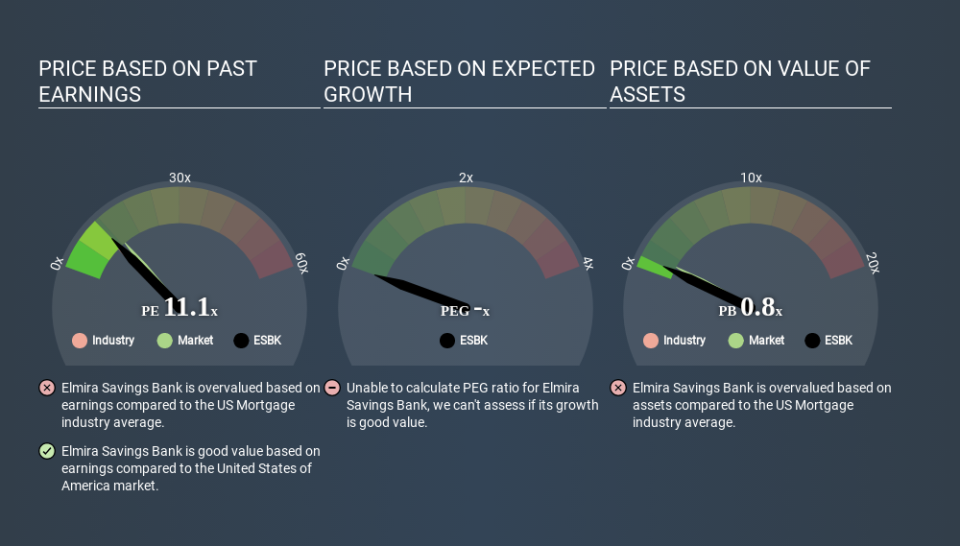How Does Elmira Savings Bank's (NASDAQ:ESBK) P/E Compare To Its Industry, After The Share Price Drop?

To the annoyance of some shareholders, Elmira Savings Bank (NASDAQ:ESBK) shares are down a considerable 31% in the last month. Indeed the recent decline has arguably caused some bitterness for shareholders who have held through the 34% drop over twelve months.
Assuming nothing else has changed, a lower share price makes a stock more attractive to potential buyers. In the long term, share prices tend to follow earnings per share, but in the short term prices bounce around in response to short term factors (which are not always obvious). So, on certain occasions, long term focussed investors try to take advantage of pessimistic expectations to buy shares at a better price. One way to gauge market expectations of a stock is to look at its Price to Earnings Ratio (PE Ratio). A high P/E ratio means that investors have a high expectation about future growth, while a low P/E ratio means they have low expectations about future growth.
View our latest analysis for Elmira Savings Bank
How Does Elmira Savings Bank's P/E Ratio Compare To Its Peers?
Elmira Savings Bank's P/E of 11.07 indicates some degree of optimism towards the stock. You can see in the image below that the average P/E (10.0) for companies in the mortgage industry is lower than Elmira Savings Bank's P/E.
Its relatively high P/E ratio indicates that Elmira Savings Bank shareholders think it will perform better than other companies in its industry classification. The market is optimistic about the future, but that doesn't guarantee future growth. So further research is always essential. I often monitor director buying and selling.
How Growth Rates Impact P/E Ratios
Companies that shrink earnings per share quickly will rapidly decrease the 'E' in the equation. That means even if the current P/E is low, it will increase over time if the share price stays flat. Then, a higher P/E might scare off shareholders, pushing the share price down.
Elmira Savings Bank's earnings per share fell by 18% in the last twelve months. And EPS is down 6.0% a year, over the last 3 years. This could justify a low P/E.
Remember: P/E Ratios Don't Consider The Balance Sheet
Don't forget that the P/E ratio considers market capitalization. So it won't reflect the advantage of cash, or disadvantage of debt. The exact same company would hypothetically deserve a higher P/E ratio if it had a strong balance sheet, than if it had a weak one with lots of debt, because a cashed up company can spend on growth.
Such spending might be good or bad, overall, but the key point here is that you need to look at debt to understand the P/E ratio in context.
How Does Elmira Savings Bank's Debt Impact Its P/E Ratio?
Elmira Savings Bank's net debt equates to 44% of its market capitalization. While it's worth keeping this in mind, it isn't a worry.
The Verdict On Elmira Savings Bank's P/E Ratio
Elmira Savings Bank has a P/E of 11.1. That's below the average in the US market, which is 12.5. Since it only carries a modest debt load, it's likely the low expectations implied by the P/E ratio arise from the lack of recent earnings growth. What can be absolutely certain is that the market has become less optimistic about Elmira Savings Bank over the last month, with the P/E ratio falling from 16.0 back then to 11.1 today. For those who prefer to invest with the flow of momentum, that might be a bad sign, but for a contrarian, it may signal opportunity.
Investors should be looking to buy stocks that the market is wrong about. If the reality for a company is not as bad as the P/E ratio indicates, then the share price should increase as the market realizes this. We don't have analyst forecasts, but you could get a better understanding of its growth by checking out this more detailed historical graph of earnings, revenue and cash flow.
You might be able to find a better buy than Elmira Savings Bank. If you want a selection of possible winners, check out this free list of interesting companies that trade on a P/E below 20 (but have proven they can grow earnings).
If you spot an error that warrants correction, please contact the editor at editorial-team@simplywallst.com. This article by Simply Wall St is general in nature. It does not constitute a recommendation to buy or sell any stock, and does not take account of your objectives, or your financial situation. Simply Wall St has no position in the stocks mentioned.
We aim to bring you long-term focused research analysis driven by fundamental data. Note that our analysis may not factor in the latest price-sensitive company announcements or qualitative material. Thank you for reading.

